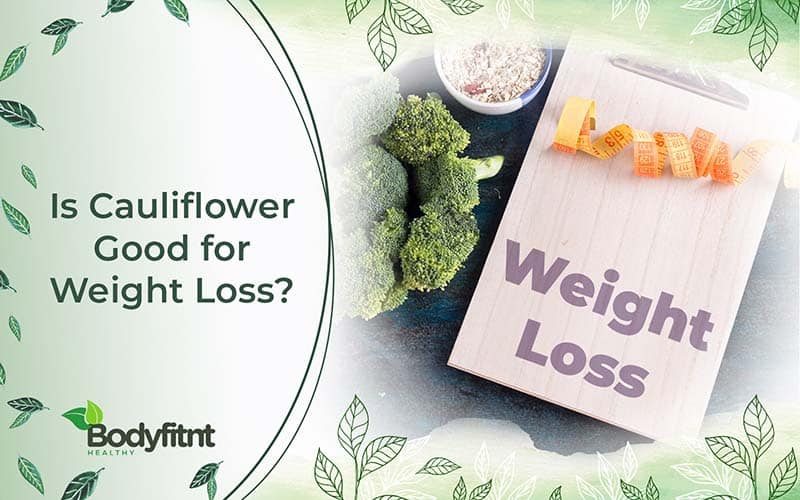Starting a weight-loss journey can feel like a big challenge, especially when it comes to choosing what to eat. If you’ve ever wondered, “Is cauliflower good for weight loss?” you’re in for a pleasant surprise!
Cauliflower might look like a simple, everyday veggie, but it’s actually a fantastic choice for anyone trying to lose weight. In this blog, we’re going to talk all about why cauliflower is so great for weight loss.
We’ll show you how cauliflower can be a super helpful part of your diet. You’ll learn why it’s such a good choice for losing weight, and we’ll give you some easy, tasty ways to add it to your meals. So, get ready to discover how cauliflower can help you on your weight loss journey, with lots of fun tips and ideas for making it a regular part of what you eat!
How Is Cauliflower Good for Weight Loss?
Cauliflower is a fantastic addition to your diet if you’re looking to shed some pounds. Here’s why this unassuming vegetable can play a role in your weight loss journey:
- Low in Calories: A mere cup of cauliflower contains just 25 calories, making it a smart choice for anyone aiming to cut down their calorie intake as part of a weight loss plan.
- High in Fiber: Cauliflower is a fiber-rich gem, and that’s great news for your waistline. Fiber keeps you feeling full for longer, curbing those pesky cravings and helping with portion control. Plus, it’s excellent for your digestive health and prevents constipation.
- Low in Carbs: If you’re on a low-carb or ketogenic diet, cauliflower is your ally. A single cup of cauliflower, weighing approximately 107 grams, contains a modest 5 grams of carbohydrates. Contrast this with rice: a cup weighing 158 grams packs a substantial 44 grams of carbohydrates. This means that rice contains nearly nine times more carbohydrates than an equivalent amount of cauliflower. It’s low in carbohydrates, which can help kickstart ketosis—a state where your body burns fat for energy, aiding weight loss.
- Versatility: Cauliflower is a culinary chameleon. You can swap it for calorie-heavy staples like rice, potatoes, or pasta. Create dishes like cauliflower “fried” rice or “mashed” potatoes, enjoying the flavors without the calorie overload.
- Nutrient-Rich: Cauliflower packs a punch of essential vitamins and minerals like vitamin C, vitamin K, and folate. These nutrients are vital for overall health and incorporating them into your diet while keeping an eye on calories is a win-win.
- Potential Fat Burner: Cruciferous vegetables like cauliflower may possess fat-burning properties due to their glucosinolate content.

Keep in mind that effective weight loss hinges on maintaining a calorie deficit, so don’t rely solely on cauliflower. Pair it with a balanced diet, portion control, and regular physical activity for the best results.
Effective Ways to Lose Weight with Cauliflower
Losing weight with cauliflower is not only healthy but also delicious. Here are some effective ways to make the most of cauliflower for weight loss:
- Cauliflower is a versatile replacement for calorie-laden ingredients. Try cauliflower rice or mashed cauliflower instead of white rice or potatoes in your recipes. This simple switch can significantly cut down your calorie intake.
- Get creative with cauliflower-based dishes like cauliflower pizza crust, “fried” cauliflower rice, or cauliflower mac and cheese. These alternatives offer satisfaction without the calorie overload of their traditional counterparts.
- Boost your vegetable intake by blending cauliflower into your smoothies. It adds volume and nutrients without piling on extra calories. This trick helps you stay full for longer, aiding in portion control.
- Transform cauliflower florets into a tasty snack by roasting or baking them. Season them with your favorite spices for a low-calorie, nutrient-packed treat that satisfies your cravings without derailing your weight loss efforts.
- Opt for cauliflower-based side dishes like roasted cauliflower, cauliflower gratin, or cauliflower casserole instead of higher-calorie alternatives. These options contribute to your daily vegetable intake while helping to manage your calorie consumption.
- Make cauliflower a regular part of your meal plan. Consistently including cauliflower in your diet will increase your overall vegetable intake and contribute to maintaining a calorie-controlled eating pattern.
How Long Does It Take to See Weight Loss Effects with Cauliflower?
The time it takes to see results can differ from person to person due to multiple factors. Let’s break it down to make it clearer:
- Short-Term Effects (Within a Few Weeks): In the short term, usually within a week or two, you may notice some immediate benefits. Cauliflower’s low-calorie and high-fiber content can help reduce bloating and lead to initial weight loss by promoting feelings of fullness.
- Long-Term Effects (Several Weeks to Months): For substantial and lasting weight loss, it’s essential to make cauliflower a consistent part of a balanced, calorie-controlled diet combined with regular exercise. It may take several weeks to months to observe noticeable changes in your weight and body composition. Patience and persistence are key.
- Cauliflower Diet: Some individuals opt for specialized diets, such as the cauliflower diet, where cauliflower replaces high-carb foods in various dishes. This approach may potentially expedite weight loss, but the outcome still depends on individual factors like metabolism and adherence to the diet.

Essential Things to Note When Losing Weight with Cauliflower
Leveraging cauliflower for weight loss can be highly beneficial, yet there are critical strategies to ensure success. Here’s what you need to know:
- Mindful Portions: Despite its low-calorie profile, overindulging in cauliflower can inadvertently lead to weight gain. It’s crucial to monitor portions, keeping servings in check to avoid excess.
- Combine with Protein: Since cauliflower falls short in protein, complement it with high-protein foods like poultry, seafood, eggs, or plant-based alternatives such as tofu. This pairing helps in maintaining satiety and curbing hunger pangs.
- Cooking Matters: Cauliflower’s versatility allows for various cooking methods. However, to maintain its low-calorie advantage, prefer steaming, roasting, or light sautéing over calorie-dense methods like deep-frying or breading.
- Sauce Savvy: Recipes often call for coating cauliflower in rich sauces or cheeses. Opt for healthier, low-calorie seasonings such as herbs, spices, or a splash of lemon to enhance flavor without the calorie overload.
- Balanced Diet Integration: While cauliflower is a stellar choice, it shouldn’t monopolize your diet. Ensure a rich mix of other nutritious elements like fruits, other vegetables, whole grains, lean proteins, and essential fats for a well-rounded diet.
- Variety is Key: Over-reliance on cauliflower can lead to nutritional imbalances. Diversify your vegetable intake, incorporating a wide range of nutrient-packed options.
- Nutrient Awareness: Cauliflower is an excellent source of vitamins C and K, but it’s not a one-stop-shop for all nutrients. It lacks significant protein, healthy fats, and fiber, so it’s wise to pair it with foods that fill these gaps.
- Calorie Deficit with Care: While it’s true cauliflower can aid in creating a calorie deficit, extreme dieting is not advisable. Aiming for a gradual, healthy weight loss of about 1-2 pounds per week is a sustainable and safer approach.
Conclusion
In conclusion, cauliflower’s weight loss benefits are undeniable. It’s a versatile, low-calorie superstar that can transform your journey to a healthier you. Have you experienced the cauliflower effect? Share your success stories with us! And for more insightful blogs on health and nutrition, explore our collection at Bodyfitnt. Together, we’ll continue to unravel the wonders of “Is cauliflower good for weight loss?” for a brighter, healthier future.

Born on July 26, 1960, Professor Tim Olds is a leading authority in the field of health sciences, focusing on exercise science, nutrition, and well-being. As the Bradley Distinguished Professor at the University of South Australia, his research offers pivotal insights into the effects of physical activity, diet, and lifestyle on health outcomes for both men and women.
Having completed two PhDs, one in French Studies and the other in exercise science, Professor Olds has uniquely blended his academic background to explore the multifaceted connections between human behavior, physical fitness, and nutrition. His work in mathematical modeling of cycling performance, anthropometry, and trends in fitness and fatness has informed strategies for weight management and healthy living.
Professor Olds served as the Project Director for the Australian National Nutrition and Physical Activity Survey, examining how diet and physical activity influence health on a national scale. His work on the ADAPT Project, focusing on 3D anthropometry, further showcased his innovative approach to understanding human physicality.
With numerous influential publications, Professor Olds has contributed substantially to the public’s understanding of diet, weight loss, and personalized fitness strategies. His findings have been instrumental in shaping health policies and behavioral change programs aimed at improving individual and community wellness.
From exploring women’s health concerns to understanding men’s fitness needs, Professor Olds’s research transcends gender barriers and offers a comprehensive view of the role of exercise and nutrition in enhancing life quality. His enduring commitment to health education and advocacy continues to inspire people to make informed decisions for a balanced and healthy life.
Professor Tim Olds’s trailblazing work stands as a vital resource for anyone interested in embracing a healthier lifestyle, understanding the science of physical activity, or pursuing effective strategies for diet and weight loss. His academic excellence and practical wisdom make him an essential voice in the ongoing conversation about health and well-being in the modern world.
PUBLISHED ARTICLES
- Olds, T. (2012). Evidence for a Sugars-to-Mental Health Pipeline. Atherosclerosis Supplements, 13(4), 29-30.
- Olds, T., Maher, C., & Zumin, S. (2011). The evolution of screen time: What’s next? Journal of Physical Activity and Health, 8(2), 236-244.
- Olds, T., Ferrar, K., Schranz, N., & Maher, C. (2013). Obese adolescents are less active than their normal‐weight peers, but wherein lies the difference? Journal of Adolescent Health, 53(6), 768-774.
- Olds, T., Maher, C., & Matricciani, L. (2010). Sleep duration or bedtime? Exploring the relationship between sleep habits and weight status and activity patterns. Sleep, 33(12), 1576-1581.
- Olds, T., Ridley, K., & Dollman, J. (2006). Screenieboppers and extreme screenies: The place of screen time in the time budgets of 10–13 year‐old Australian children. Australian and New Zealand Journal of Public Health, 30(2), 137-142.
These published articles reflect Professor Tim Olds’ contributions to various aspects of physical activity, sedentary behavior, and health-related research. They provide insights into the intricate relationship between lifestyle choices and health outcomes

